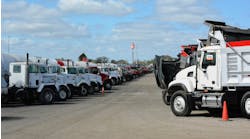For the first half of 2021, most fleets were recovering from the shutdowns of 2020 and spent the first quarter of the year trying to get back to some form of normalcy. With transportation opening up, we saw an aggressive increase in demand for capacity as we were dealing with a year’s worth of pent-up consumer spending. And this pent-up demand was across all sectors of the economy.
Just as things were moving along nicely, we started to see material shortages occur throughout the supply chain. It started with microchips but has grown to include things like wiring harnesses and tires and raw materials like steel and wood. Today, almost every truck manufacturer has nearly complete vehicles sitting on the sidelines waiting for the sensors to arrive so that the trucks can be delivered. Collectively, manufacturers have delayed manufacturing timelines in some cases by 90 to 100 days.
What does that mean for fleets?
If you have not yet ordered trucks for 2021, you will be unable to get them before the year ends and may not even be able to take delivery until well into 2022. On top of that, the used-truck supply has been decimated as fleets that traditionally bought new vehicles were forced to enter the used-truck market to get the extra vehicles they needed to meet the increased capacity demand. They paid steep prices for those used assets, too, as the basic principles of supply and demand ruled the market.
There is a lesson to be learned from all of this: Planning well into the future for our business needs is an absolute requirement going forward. Without it, you are going to be left on the sidelines.
In many cases, fleet managers wait until October to submit their business plans to company management, and once approved they place orders in the January-February time frame for delivery throughout the year. I am here to tell you, that kind of thinking is a thing of the past.
You need to begin planning for 2022 today. First-quarter 2022 order boards are already full so if you need new trucks in Q1, you are out of luck. If you have not done your capex planning, I suggest you do it immediately so you can get approval from finance and treasury as soon as possible and place orders to get equipment in 2022.
No one knows what the future will hold. Will economic activity remain strong? Is inflation going to rise? There are many “what ifs”, so make sure you have flexibility in your plans in case demand softens. Work with your manufacturers so that you can adjust the size of your order as business conditions change.
As for the chip shortage, I have yet to hear when that is expected to end, some are saying it will be a multiyear issue, so we likely will continue to see manufacturing constraints, which makes planning now for the future even more important.
One last point: Delays delivery mean you are going to have to keep existing assets longer than planned. As your fleet gets older, the vehicles are going to require more maintenance and repair. This may mean that you will need to add technicians to your staff, and you may have to adjust parts inventory levels because materials shortages are impacting the aftermarket as well. If you outsource your maintenance and repair, talk to your service provider to make sure they will have the parts and technicians needed to keep your older assets on the road.
At this point, you can’t do anything about 2021, but you can position yourself for the future by planning for 2022 and beyond starting today, keeping in mind all the changing market dynamics.




